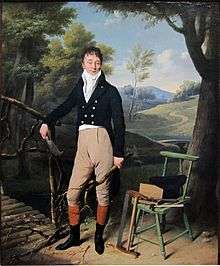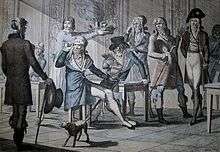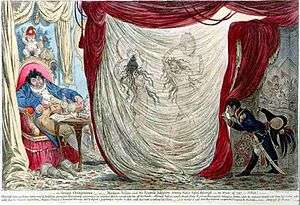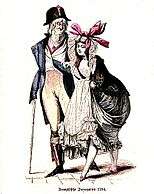Incroyables and Merveilleuses

The Incroyables ("incredibles") and their female counterparts, the Merveilleuses ("marvelous women", roughly equivalent to "fabulous divas"), were members of a fashionable aristocratic subculture in Paris during the French Directory (1795–1799). Whether as catharsis or in a need to reconnect with other survivors of the Reign of Terror, they greeted the new regime with an outbreak of luxury, decadence, and even silliness. They held hundreds of balls and started fashion trends in clothing and mannerisms that today seem exaggerated, affected, or even effete (decadent, self-indulgent). Some devotees of the trend preferred to be called "incoyable" or "meveilleuse", thus avoiding the letter R, as in "révolution." When this period ended, society took a more sober and modest turn.
Members of the ruling classes were also among the movement's leading figures, and the group heavily influenced the politics, clothing, and arts of the period. They emerged from the muscadins, a term for dandyish anti-Jacobin street gangs in Paris from 1793 [n 1] who were important politically for some two years; the terms are often used interchangeably, though the muscadins were of a lower social background, being largely middle-class.
Social background
Ornate carriages reappeared on the streets of Paris the day after the execution (28 July 1794) of Maximilien Robespierre, which brought an end to the Jacobin-era Committee of Public Safety and signaled the commencement of the Thermidorian Reaction. There were masters and servants once more in Paris, and the city erupted in a furor of pleasure-seeking and entertainment. Theaters thrived, and popular music satirized the excesses of the Revolution. One popular song of the period called on the French people to "share my horror" and to send "these drinkers of human blood" back amongst the monsters from which they had sprung. Its lyrics rejoiced that "your tormentors finally grow pale at the tardy dawn of vengeance".[1]


Many public balls were bals des victimes at which young aristocrats who had lost loved ones to the guillotine danced in mourning dress or wore black armbands, greeting one another with violent movements of the head as if in decapitation.[n 2] A ball held at the Hôtel Thellusson on the rue de Provence in the 9th arrondissement of Paris restricted its guest list to the grown children of the guillotined.[2]
Clothing and fashion

The Merveilleuses scandalized Paris with dresses and tunics modeled after the ancient Greeks and Romans, cut of light or even transparent linen and gauze. Sometimes so revealing they were termed "woven air", many gowns displayed cleavage and were too tight to allow pockets. To carry even a handkerchief, the ladies had to use small bags known as reticules.[3] They were fond of wigs, often choosing blonde because the Paris Commune had banned blonde wigs, but they also wore them in black, blue, and green. Enormous hats, short curls like those on Roman busts, and Greek-style sandals were the rage. The sandals tied above the ankle with crossed ribbons or strings of pearls. Exotic and expensive scents fabricated by perfume houses like Parfums Lubin were worn as both for style and as indicators of social station. Thérésa Tallien, known as "Our Lady of Thermidor", wore expensive rings on the toes of her bare feet and gold circlets on her legs.
The Incroyables wore eccentric outfits: large earrings, green jackets, wide trousers, huge neckties, thick glasses, and hats topped by "dog ears", their hair falling on their ears. Their musk-based fragrances earned them too the derogatory nickname muscadins among the lower classes, already applied to a wide group of anti-jacobins. They wore bicorne hats and carried bludgeons, which they referred to as their "executive power." Hair was often shoulder-length, sometimes pulled up in the back with a comb to imitate the hairstyles of the condemned. Some sported large monocles, and they frequently affected a lisp and sometimes a stooped hunchbacked posture.
In addition to Madame Tallien, famous Merveilleuses included Anne Françoise Elizabeth Lange, Jeanne Françoise Julie Adélaïde Récamier, and two very popular Créoles: Fortunée Hamelin and Hortense de Beauharnais. Hortense, a daughter of the Empress Josephine, married Louis Bonaparte and became the mother of Napoleon III. Fortunée was not born rich, but she became famous for her salons and her string of prominent lovers. Parisian society compared Germaine de Staël and Mme Raguet to Minerva and Juno and named their garments for Roman deities: gowns were styled Flora or Diana, and tunics were styled à la Ceres or Minerva.[4]
The leading Incroyable, Paul François Jean Nicolas, vicomte de Barras, was one of five directors who ran the Republic of France and gave the period its name. He hosted luxurious feasts attended by royalists, repentant Jacobins, ladies, and courtesans. Since divorce was now legal, sexuality was looser than in the past. However, de Barras' reputation for immorality may have been a factor in his later overthrow, a coup that brought the French Consulate to power and paved the way for Napoleon Bonaparte.
Representation in the arts

The fictional nouveau riche social climber Madame Angot, awkwardly wearing ridiculous Greek clothing, parodied the Merveilleuses in many plays of the period. Carl Vernet's caricatures of the wardrobes of the Incroyables and Merveilleuses met with contemporary popular success.
Canadian webcomic artist Kate Beaton has created similar caricatures, which featured in her comic Hark! a Vagrant, comparing the Merveilleuses to the modern-day hipster subculture.[5]


Images of the period
.jpg) Full and half dress for April 1809
Full and half dress for April 1809 Les-Modernes-Incroyables, 1810
Les-Modernes-Incroyables, 1810 Les Incroyables
Les Incroyables Incroyable
Incroyable French dandy
French dandy Incroyable et Merveilleuse
Incroyable et Merveilleuse.jpg) Les Incroyables (Muscadins)
Les Incroyables (Muscadins) Point de Convention c.1797
Point de Convention c.1797
- People associated with Incroyables and Merveilleuses
.jpg) Juliette Récamier (1777-1849)
Juliette Récamier (1777-1849) Portrait de Madame de Verninac
Portrait de Madame de Verninac
Other meanings
Notes and references
- Notes
- ↑ Jacobins stood for the centralised supposed far-left republic and its terrors, so included established rulers such as Robespierre
- ↑ Romantic horror had already come to the fore in gothic fiction, beginning with The Castle of Otranto (1764); however, this theme expanded: Edgar Allan Poe (1809-1849), Mary Shelley (1797-1851), gothic novels and other-language equivalents such as the German Schauerroman and the French roman noir would all soon follow after this period.
- References
- ↑ Le Reveil du peuple, "The Awakening of the People'", written by Jean-Marie Souriguières de St Marc and set to music by Pierre Gaveaux
- ↑ Alain Rustenholz, Les traversées de Paris, Parigramme, September 2006, Evreux, ISBN 2-84096-400-7
- ↑ "Reticule". Austentation: Regency Accessories. Retrieved 4 November 2012.
- ↑ Alfred Richard Allinson, The Days of the Directoire, J. Lane, (1910), p. 190
- ↑ Beaton, Kate. "Hipsters Ruin Everything, Part 2". Hark! A Vagrant. Retrieved 5 November 2012.
- ↑ Lucky Meisenheimer. "Lucky's History of the Yo-Yo". Retrieved 26 November 2009.
Bibliography
- Barras, Paul; Mémoires de Barras, membre du Directoire (1895), Hachette, 1896
- Clarke, Joseph; Commemorating the Dead in Revolutionary France: Revolution and Remembrance, 1789–1799; Cambridge University Press, 2007.
- André Gaillot, ed. Une ancienne muscadine, Fortunée Hamelin: lettres inédites 1839–1851 (1911), Émile-Paul, 1911
Further reading
- Bourhis, Katell le: The Age of Napoleon: Costume from Revolution to Empire, 1789–1815, Metropolitan Museum of Art, 1989. ISBN 0870995707
See also
- Dandy
- 1795–1820 in fashion
- 1800s (decade)
- Jean-Lambert Tallien
- La fille de Madame Angot
- Théâtre de Paris
External links
- Merveilleuses in Fashion History
- Merveilleuses, Incroyables, Muscadins, Petites-maîtresses, Petits-maîtres, Mirliflores, Inconcevables, Amazones, Muguets, Gandins… (in French)
- thumb Letter from de Barras accepting the post of Director
- thumb De Barras at the National Library of France
| Wikimedia Commons has media related to Incroyables and Merveilleuses. |
| Wikimedia Commons has media related to Directoire. |
| Wikisource has original text related to this article: |